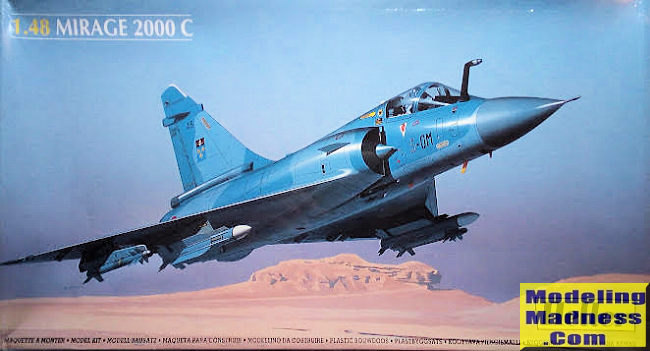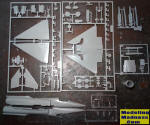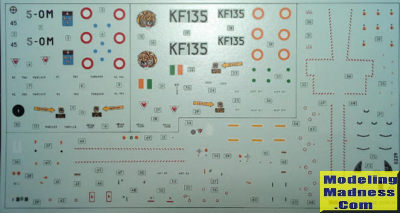
Heller 1/48 Mirage 2000C
| KIT #: | 80246 |
| PRICE: | €35 when new |
| DECALS: | Two options |
| REVIEWER: | Spiros Pendedekas |
| NOTES: |

| HISTORY |
The Mirage 2000 is a French multirole, single-engine, fourth-generation jet fighter manufactured by Dassault Aviation. It was designed in the late 1970s as a lightweight fighter to replace the Mirage III. The first aircraft were delivered in March 1976 and, while their appearance resembles the Mirage III / 5 and 50, it is a completely new aircraft with advanced systems.
Designed primarily as an all-weather interceptor, this very capable fighter evolved into a multirole aircraft with several variants developed, able to carry a wide variety of ordnance. Its latest version is the Mirage 2000-5 (with similar export variants). Over 600 aircraft were built and it has been in service with 9 nations.
| THE KIT |
 Heller first released
this kit back in 1991 as a dual seater, with the single seater following soon
after. Both versions have been re-released by Heller over the years, the
“latest” being the 2012 dual seater reissue. The dual seater version was also
reboxed in 1992 by the then “sister” Airfix, whereas in 2007 Eduard reboxed both
versions, adding their usual wonderful goodies (PE, resin, masks, decals and the
like) inside their limited edition boxings.
Heller first released
this kit back in 1991 as a dual seater, with the single seater following soon
after. Both versions have been re-released by Heller over the years, the
“latest” being the 2012 dual seater reissue. The dual seater version was also
reboxed in 1992 by the then “sister” Airfix, whereas in 2007 Eduard reboxed both
versions, adding their usual wonderful goodies (PE, resin, masks, decals and the
like) inside their limited edition boxings.
The subject kit was bought in 2007 and is the mid-90s single seater version. My
understanding is that the specific kit was not made in the mid-90s, but rather,
sometime around 2005 (meaning the molds are not brand new), since Heller kept
reissuing the exact same kit over the years.
It comes shrink wrapped in the usual nice big size Heller top opening box, with
an attractive box art of an Armée de l'Air Mirage 2000 in flight. Upon opening
the box, you are greeted with 86 light gray styrene parts packed in two bags.
The styrene itself is on the soft side, typical of Heller: it is easily workable
and well reacting to styrene glues, but the softness might be a minus when
dealing with some tiny bits, such as pitots or landing gear bits. There is also
some flash present at a few spots.
The parts are arranged
in two big and two small sprues, whereas the fuselage halves and exhaust nozzle
are provided separately. Details are engraved all over and look accurate,
depicting the actual planes panels quite realistically. This includes the
distinctive shims that are found at the upper and lower wing roots, a prominent
feature of the plane's design.
The cockpit, a most busy and key area at the Mirage 2000, is towards the spartan
side, with an almost plain tub, a flat instrument panel, a stick, a head-up
display and a not so bad Martin Baker seat. Decals render the instruments only
at the instrument panel, whereas the side consoles and sidewalls are totally
plain.
The intakes have correct external shape, but are shallow. The exhaust nozzle is
sufficiently deep, but could be busier looking. The elevons' hinge mechanisms,
the various pitots, AOA sensors and antennas. are well represented.
The equally busy in reality landing gear is also averagely represented and the
same is true for the wheel wells.
Only air-to-air ordnance is provided and includes two Matra R-530 semi-active and two Magic 550 IR missiles. No external tanks are provided, with the omission of the central one being more notable, since it is almost always worn by operational Mirage 2000s.
The transparencies are
reasonably clear, however a few sprue gates interfere with framing. Also, sadly,
they are bagged together with other sprues, meaning potential scratches.
Instructions are typical Heller, provided in the form of an A4 b/w mini booklet,
with an 8-language small history of the type at the front page. Construction is
spread in 9 steps, with the last three being relatively busy, needing some study
beforehand, nothing too serious though. Color callouts are provided only in
Humbrol codes, meaning have your conversion charts handy!
 Two schemes are provided, for a French and an Indian bird, both of them being
almost identical, with a disruptive light blue gray over light gray. The decal
sheet contains full stenciling (a must, since no Mirage2000 model looks
contained without the stencils). While its registration could be better (a not
that uncommon phenomenon with older Heller decals…), the decal sheet looks
useable.
Two schemes are provided, for a French and an Indian bird, both of them being
almost identical, with a disruptive light blue gray over light gray. The decal
sheet contains full stenciling (a must, since no Mirage2000 model looks
contained without the stencils). While its registration could be better (a not
that uncommon phenomenon with older Heller decals…), the decal sheet looks
useable.
Instructions, interestingly, want you to first assemble the landing gear, then
assemble (but not install) the cockpit, then the missiles with their pylons.
Next you have to trap the cockpit and nose wheel well between the fuselage
halves, followed by assembly and installation of the intakes. In the next dense
step you are instructed to attach the 4-piece wing, 4-piece fin, HUD and
canopies, exhaust nozzle, refueling probe and various upper fuselage details (pitots,
antennas and the like).
Final step is attachment of landing gear parts, elevons’ hinges, ordnance, main
pitot and under-fuselage antenna. As stated above, the first six construction
steps are simple, whereas the rest three are packed with a significant amount of
information; the latter are more kind of diagrams of what goes where, rather
than construction steps: nothing too serious, other than some pre-studying
required.
| CONCLUSIONS |
Though elderly, this is
a classic kit of the charming French fighter, with good general shape and
sufficient external details. On the other hand, cockpit detail is sparse,
intakes are shallow and landing gear leans towards the simplistic side, the same
being true for the exhaust nozzle. The lack of centerline tank and air-to-ground
ordnance is also notable. Instructions are clear (though they need some study)
and decals are slightly off-registered.
With its last reboxing some 10 years ago, this kit is not that easy to find
nowadays (2021). The wonderful Eduard beefed-up reboxings are even scarcer.
Since Heller tend to periodically reissue their kits, we will possibly see this
kit reboxed sometime in the future. A lot of aftermarket seems to be available,
addressing practically all kits shortfalls.
I have built this kit a few times in the past and, though not that difficult,
its fit posed some challenges, mainly at the wing-to-fuselage joints and
intakes. This means that some test fitting before gluing will be necessary.
If you own this kit or
by chance find it at an interesting price and already have a small builds under
your belt, do not hesitate to tackle it. You will end up with an imposing model
of this beautiful fighter.
Happy modeling!
December 2021
Copyright ModelingMadness.com. All rights reserved. No reproduction in part or in whole without express permission.
If you would like your product reviewed fairly and fairly quickly, please contact the editor or see other details in the Note to Contributors.